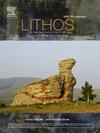Melting of amphibole-apatite-rich metasomes in the continental mantle and comparison of melt compositions with natural igneous rocks
IF 2.9
2区 地球科学
Q2 GEOCHEMISTRY & GEOPHYSICS
引用次数: 0
Abstract
The source regions of alkaline igneous melts are thought to be mixtures of peridotite, pyroxenite and hydrous ultramafic rocks, but relatively few melting experiments are available for the last of these rock groups. Here, we expand the scope of experimental results on hydrous ultramafic rocks to assemblages rich in Ca-amphibole and apatite, which are found as xenoliths in eastern Australia. Experiments were conducted at 15 kbar on five hydrous ultramafic mineral assemblages; four consisted of equal amounts of Ca-amphibole and apatite, some with minor clinopyroxene and/or phlogopite. A fifth mix consisted of 50 % each of mica and clinopyroxene, but with lower Mg# (Mg/(Mg + Fe)) than in previous experiments. Results show that Ca-amphibole melts rapidly and completely within 50–100 °C of the solidus, producing melts with melilitite-nephelinite compositions similar to the amphibole. Apatite contribution to the melt is minor (P2O5 = 2.1–4.7 wt%) and clinopyroxene crystallises as a peritectic phase. These melts are distinct from those produced from mixtures containing alkali amphibole+phlogopite in having much lower SiO2 (35–40 wt%) and low K2O/Na2O, but higher CaO and Al2O3. Melts of mica clinopyroxenites have intermediate SiO2 (41–47 wt%) and much higher K/Al.
Trace element patterns for incompatible elements show that abundances for most elements are much lower than in natural nephelinites and melilitites as long as residual apatite retains elements with high Dap/melt, but incompatible trace element abundances approach those of natural rocks if apatite melts out. Hydrous minerals exert strong control on many first-row transition elements (especially Ni and Cr) and may sequester these in the proximal parts of vein systems, removing them efficiently from migrating melts. The melting points of all hydrous ulltramafic rocks, whether rich in phlogopite, Ca-amphibole or K-richterite, are below that of water-undersaturated peridotite. High degrees of melting occur quickly if amphibole is abundant, and so significant amounts of melt may be mobile at temperatures below or close to the solidus of peridotite.
大陆地幔中富含角闪石-磷灰石的交代体的熔融及其与天然火成岩的熔融成分比较
碱性火成岩熔体的源区被认为是橄榄岩、辉石岩和含水超镁铁质岩石的混合物,但对最后一类岩石的熔融实验相对较少。在此,我们将含水超镁质岩的实验结果扩展到富含钙角闪洞和磷灰石的组合,这些组合在澳大利亚东部以捕虏体的形式发现。在15kbar下对5种含水超镁质矿物组合进行了实验;四个由等量的钙角闪石和磷灰石组成,一些含有少量的斜辉石和/或绿云母。第五种混合物由云母和斜辉各占50%组成,但Mg# (Mg/(Mg + Fe))比以前的实验低。结果表明,ca -角闪孔在固相温度50-100℃范围内迅速完全熔化,产生的熔体具有与角闪孔相似的千闪石-钠辉石组成。磷灰石对熔体的贡献很小(P2O5 = 2.1-4.7 wt%),斜辉石结晶为包晶相。这些熔体与含碱角闪孔+绿云母的混合物所产生的熔体不同,其SiO2 (35-40 wt%)和K2O/Na2O较低,但CaO和Al2O3较高。云母斜辉长岩熔体具有中等SiO2 (41-47 wt%)和较高的K/Al。不相容元素的微量元素谱图表明,当残余磷灰石保留高Dap/melt元素时,大多数元素的丰度远低于天然钠云母岩和镁云母岩,而当磷灰石熔出时,不相容元素丰度接近天然岩石。含水矿物对许多第一排过渡元素(特别是Ni和Cr)起着很强的控制作用,并可能将它们隔离在脉系的近端,有效地将它们从迁移的熔体中移除。所有含水超通质岩石的熔点均低于水不饱和橄榄岩,无论是富含绿云母、钙角闪洞还是钾辉石。如果角闪洞丰富,高度的熔化发生得很快,因此大量的熔体在低于或接近橄榄岩固体的温度下可能是可移动的。
本文章由计算机程序翻译,如有差异,请以英文原文为准。
求助全文
约1分钟内获得全文
求助全文
来源期刊

Lithos
地学-地球化学与地球物理
CiteScore
6.80
自引率
11.40%
发文量
286
审稿时长
3.5 months
期刊介绍:
Lithos publishes original research papers on the petrology, geochemistry and petrogenesis of igneous and metamorphic rocks. Papers on mineralogy/mineral physics related to petrology and petrogenetic problems are also welcomed.
 求助内容:
求助内容: 应助结果提醒方式:
应助结果提醒方式:


